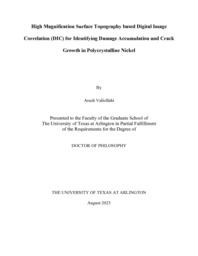
ATTENTION: The works hosted here are being migrated to a new repository that will consolidate resources, improve discoverability, and better show UTA's research impact on the global community. We will update authors as the migration progresses. Please see MavMatrix for more information.
Show simple item record
| dc.contributor.advisor | Huang, Haiying | |
| dc.creator | Valiollahi, Arash | |
| dc.date.accessioned | 2023-09-27T16:30:04Z | |
| dc.date.available | 2023-09-27T16:30:04Z | |
| dc.date.created | 2023-08 | |
| dc.date.issued | 2023-08-09 | |
| dc.date.submitted | August 2023 | |
| dc.identifier.uri | http://hdl.handle.net/10106/31724 | |
| dc.description.abstract | Damage index parameters that have been formulated to identify damage localization in plastically deformed materials typically require all six stress or strain components. Recently, simulations through Crystal Plasticity Finite Element Method (CPFEM) have been widely used to extract damage initiation parameters. However, these models are rarely verified due to the challenges in measuring the out-of-plane deformation/strain experimentally. A damage index combining the effective plastic strain and surface roughness change is investigated for identifying damage accumulation sites and predicting crack propagation path in polycrystalline pure Nickel. A novel Digital Image Correlation (DIC) technique is developed to measure both in-plane and out-of-plane deformation from surface topography images acquired using optical interferometry. A simple technique that creates random, micro size reflective speckles for sub-grain strain calculation is demonstrated. Damage accumulation sites detected by the effective strain, surface roughness change, and the combined damage index are assessed in terms of damage localization and localization consistency. The combined damage index provides an enhanced damage localization and localization consistency compared to effective plastic strain or surface roughness damage index alone. The detected damage accumulation sites were correlated with grain orientations that favor “sunken” out-of-plane deformations and large misorientations among neighboring grains. The proposed combined damage index is then used to predict the future propagation path of microstructurally small crack (MSC) in a fatigue sample. Effective plastic strain, surface roughness and combined damage index maps were constructed during the crack arresting period. The crack future propagation path was then predicted by two approaches based on ‘highest intensity’ and ‘confidence threshold’. The predicted path by the three damage indices was compared to the actual crack path. The combined damage index provided a more accurate, consistent, and confident prediction of sharp turns in crack tortuous path. Finally, A 2D Finite Element Model (FEM) is generated to verify the strain calculation approach based on theoretical strain-displacement equations. The verified strain-displacement equation can be later used to calculate the out-of-plane strain components based on surface height difference. However, the small height difference in a highly polished sample leads to large errors in out-of-plane strain calculation. Thus, a threshold value for minimum height difference between two points should be defined for error reduction in out-of-plane shear strain calculation. At the end of this study, a methodology for estimating this threshold value through FE analysis is suggested for future studies. | |
| dc.format.mimetype | application/pdf | |
| dc.subject | Scanning White Light Interferometry (SWLI) | |
| dc.subject | Digital Image Correlation (DIC) | |
| dc.subject | Damage index | |
| dc.subject | Damage accumulation | |
| dc.subject | Crack propagation | |
| dc.subject | Fatigue | |
| dc.subject | Microstructure | |
| dc.subject | Strain | |
| dc.subject | Surface roughness | |
| dc.title | High Magnification Surface Topography based Digital Image Correlation (DIC) for Identifying Damage Accumulation and Crack Growth in Polycrystalline Nickel | |
| dc.type | Thesis | |
| dc.date.updated | 2023-09-27T16:30:04Z | |
| thesis.degree.department | Mechanical and Aerospace Engineering | |
| thesis.degree.grantor | The University of Texas at Arlington | |
| thesis.degree.level | Doctoral | |
| thesis.degree.name | Doctor of Philosophy in Mechanical Engineering | |
| dc.type.material | text | |
Files in this item
- Name:
- VALIOLLAHI-DISSERTATION-2023.pdf
- Size:
- 14.20Mb
- Format:
- PDF
This item appears in the following Collection(s)
Show simple item record


